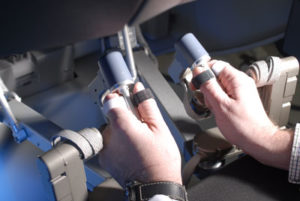

The da Vinci Robotics Case
 Over the years a branch of surgery that uses robotics and is known as “minimally invasive surgery” has been evolving. Minimally invasive surgery involves making small incisions only large enough to pass tubes into the body. It is through these tubes or trocars that a tiny video camera and cutting and grasping tools are passed. The surgeon manipulates the end of a surgical tool outside the body while viewing the action inside the body on a TV monitor. Minimally invasive surgery is meant to replace the typically long incisions of an open procedure.
Over the years a branch of surgery that uses robotics and is known as “minimally invasive surgery” has been evolving. Minimally invasive surgery involves making small incisions only large enough to pass tubes into the body. It is through these tubes or trocars that a tiny video camera and cutting and grasping tools are passed. The surgeon manipulates the end of a surgical tool outside the body while viewing the action inside the body on a TV monitor. Minimally invasive surgery is meant to replace the typically long incisions of an open procedure.
The advantages of smaller incisions include less bleeding, shorter hospital stays, shorter recovery times, and less pain. Minimally invasive surgery in the abdomen is known as laparoscopy, while surgery in the shoulder or knee is known as arthroscopy.
Learning to perform surgery by watching a TV monitor while manipulating surgical tools takes practice. The traditional sense of feel of a surgeon’s hand on the anatomy is largely gone. The view from the monitor can be confusing. There is poor depth perception. It is well known that a learning curve exists in which surgeons get better at the procedure as they do more cases. In the early days of laparoscopic surgery, established surgeons took continuing education courses to learn the new techniques. Now, minimally invasive surgery is part of the curriculum of residency programs and fellowships.
In 1999, Intuitive Surgical, Inc. introduced the da Vinci robotics system. This was touted as an extension of laparoscopic technology. The da Vinci robot involves a machine with four arms. Trocars and surgical tools connected to the robotic arms are then placed into the body. A high-definition video camera is also utilized. The surgeon sits at a console located at a distance from the operating table. The surgeon grasps endo-wrist controls and places his or her feet on pedals and looks into a monitor.
Unlike the typical laparoscopic monitor, the da Vinci monitor offers a high-definition, 3D, color, magnified image. The da Vinci system boasts increased surgical dexterity and precision of movement. Often, surgeons with no laparoscopic training are drawn to the da Vinci robot as a way to satisfy an increasing patient demand for minimally invasive surgery. Despite the large technical advances with robotic surgery, there is also a significant learning curve. The procedure is only as good as the surgeon behind the console.
We recently represented a gentleman with prostate cancer who elected to have his prostatectomy (surgical removal of the prostate) performed in a robotic fashion. The client had an elevated PSA (prostate-specific antigen, a potential marker for cancer). The robotic surgery was marketed as a more precise surgery than an open procedure, with lower risk of permanent incontinence and impotence. The purpose of prostatectomy for prostate cancer is to remove the entire prostate since the disease is typically located in more than one area. There is no benefit to leaving part of the prostate behind unless the entire gland cannot be safely removed. A typical prostate in a 50 year old man may be between 30 to 50 grams in weight.
In this, our client’s medical malpractice case, the cancer was located solely within the prostate without any extension beyond the gland. Removal of the entire gland would most probably amount to cure of the disease. The operative report described a flawless surgery without complications. However, a careful review of the records, including the pathology report, reflected only seven grams of prostate tissue was actually removed following surgery. The majority of the prostate remained and continued to express PSA.
The surgeon reacted to the continued PSA as evidence of residual cancer. He ordered radiation therapy to kill the remaining cancer. The 8 week course of radiation, on top of the trauma of surgery, caused urinary obstruction and permanent impotence. After months of agonizing episodes of obstruction, the client underwent a major diversion surgery which involved removal of his bladder and creation of a “pouch” for urine collection made from his bowel. The client must catheterize himself four to six times per day through a hole in his abdomen in order to urinate.
Our experienced law firm, Kassel McVey presented testimony from a highly experienced robotic surgeon who had performed over 500 robotic surgeries. His review of the case demonstrated that the surgeon in this case got lost during the surgery and only removed the upper portion of the prostate, yet believed he had removed the entire gland. The error occurred from lack of experience and improper supervision. The surgeon had only performed seven prior robotic surgeries. The expert testified that no condition existed in the patient which prevented complete removal of the prostate. If the entire prostate had indeed been removed, there would have been no need for radiation. Without radiation, there were have been no injury to the client.
Despite the highly advanced technology of the da Vinci robot, surgery experience is critical. One leading expert opined that at least 30 to 60 completed surgeries were needed to achieve a “window of safety” and to be proficient in the procedure. A reasonable settlement was achieved for our client.
Personal Injury Lawyers 1330 Laurel Street Columbia, SC 29201 Phone: 803-256-4242
Mailing Address
Post Office Box 1476
Columbia, South Carolina 29202
Fax: (803) 256-1952
Copyright © 2023 John D. Kassel, Attorney at Law, LLC. All rights reserved. Privacy Policy I Terms of Service | Disclaimer
This website is designed for general information only. The information should not be construed to constitute formal legal advice or the formation of a lawyer/client relationship. The results and testimonials listed on this website are specific to the facts and legal circumstances of specific cases and should not be used to form an expectation that the same results could be obtained for other clients in similar matters. This list is not a description or characterization of the quality of the firm's representation, it is not intended to compare one attorney's work to another and is in no way a guarantee of a specific result for your case.

